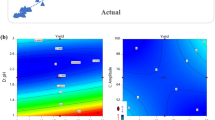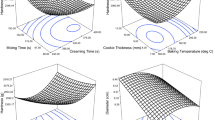Abstract
This study examined the optimal ingredient mixing ratio for the preparation of sponge cake containing turmeric powder. After preliminary studies, the following ingredient ranges were determined: 116.0–129.5% sugar, 0.5–5.0% turmeric powder, and 10.0–23.5% oil. Among the different mixture designs, the D-optimal design was chosen for analysis. Linear models were applied to determine the color values of lightness, redness, and yellowness, as well as textural values for hardness, gumminess, and chewiness. A quadric model was used to determine all the categories in the sensory analysis. The fitness analysis results showed that in all the sensory characteristics, the probabilities were significant within 5%; thus, the models were accepted as appropriate. The response surface and trace plot results showed that increasing amounts of turmeric powder decreased the brightness, and increased redness and yellowness. In addition, increasing amounts of turmeric powder caused an increase in the hardness, gumminess, and chewiness, and thus the softness of the cake decreased. Cake samples received low sensory evaluation scores when sugar, turmeric powder, and oil were added above their optimal levels. In the numeric optimization analysis, the optimal ingredient amounts were 123.4% sugar, 1.6% turmeric powder, and 14.9% oil. The above results demonstrate the feasibility of adding turmeric powder to sponge cake. Thus, the commercialization of a turmeric sponge cake marketed as a functional food was deemed possible.
Similar content being viewed by others
References
Institute of Dictionary of Oriental Medicine. Dictionary of Oriental Medicine. Yeokang Publishing Company, Seoul, Korea. p. 839 (2005)
Lee YE, Hong SH. Traditional Oriental Medicine Food Material Science. Kyomunsa, Seoul, Korea. pp. 284–285 (2003)
Cha JH. Traditional Oriental Pharmacy. Ilwol, Seoul, Korea. pp. 170–172 (1990)
Ok ES. Herbology. Shinkwang Publishing Company, Seoul, Korea. pp. 284–285 (2004)
Ryu SR, Han KJ, Jang HD. Separation and purification of effectiveness components from ulgeum (Curcuma longa) and the test study of anticancer effects that use its. Appl. Chem. 9: 69–72 (2005)
Mukhopadhyay MJ, Saha A, Mukherjee A. Studies on the anticlastogenic effect of turmeric and curcumin on cyclophosphamide and mitomycin C in vivo. Food Chem. Toxicol. 36: 73–76 (1998)
Thongchai W, Liawruangrath B, Liawruangrath S. Flow injection analysis of total curcuminoids in turmeric and total antioxidant capacity using 2,2-diphenyl-1-picrylhydrazyl assay. Food Chem. 112: 494–499 (2009)
Kang WS, Kim JH, Park EJ, Yoon KR. Antioxidative property of turmeric (Curcumae Rhizoma) ethanol extract. Korean J. Food Sci. Technol. 30: 266–271 (1998)
Choi SW, Yang JS, Lee HS, Kim DS, Bai DH, Yu JH. Characterization of squalene synthase inhibitor isolated from Curcuma longa. Korean J. Food Sci. Technol. 35: 297–301 (2003)
Began G, Goto M, Kodama A, Hirose T. Response surfaces of total oil yield of turmeric (Curcuma longa) in supercritical carbon dioxide. Food Res. Int. 33: 341–345 (2000)
Chi HJ, Kim HS. Curcumin content of cultivated turmeric in Korea. Korean J. Pharmacogn. 14: 67–69 (1983)
Lee HS. Antimicrobial properties of turmeric (Curcuma longa L.) rhizome-derived ar-turmerone and curcumin. Food Sci. Biotechnol. 15: 559–563 (2006)
Lee JM, Jun WJ. Methanolic extract of turmeric (Curcuma longa L.) enhanced the lipolysis by up-regulation of lipase mRNA expression in differentiated 3T3-L1 adipocytes. Food Sci. Biotechnol. 18: 1500–1504 (2009)
Gilda S, Kanitkar M, Bhonde R, Paradkar A. Activity of watersoluble turmeric extract using hydrophilic excipients. LWT -Food Sci. Technol. 43: 59–66 (2010)
Ellekjæ T, Baardseth P. Milk protein affect yield and sensory quality of cooked sausages. J. Food Sci. 61: 660–666 (1996)
Næs T, Færgestad EM, Cornell J. A comparison of methods for analyzing data from a three component mixture experiment in the presence of variation created by two process variables. Chemometr. Intell. Lab. 41: 221–235 (1998)
Næs T, Bjerke F, Færgestad EM. A comparison of design and analysis techniques for mixtures. Food Qual. Prefer. 10: 209–217 (1999)
Kwhak SH. Optimization for the preparation of steamed foam cakes by mixing methods using response surface methodology. PhD thesis, Dankook University, Seoul, Korea (2004)
Myers RH, Montgomery DC. Response Surface Methodology: Process and Product Optimization Using Designed Experiments. John Wiley & Sons, New York, NY, USA. pp. 364–370 (1995)
Raymond HM. Response Surface Methodology: Process and Product Optimization Using Designed Experiments. John Wiley & Sons, New York, USA. pp. 558–562 (1995)
Derringer G, Suich R. Simultaneous optimization of several response variables. J. Qual. Technol. 12: 214–219 (1980)
Bourne MC. Texture profile analysis. J. Food Technol. 1: 32–62 (1978)
Kim YS, Kwak SH, Myung SJ. Optimization of ingredient mixing ratio for preparation of steamed foam cake with added saltwort (Salicornia herbacea L.). Korean J. Food Cookery Sci. 23: 666–680 (2006)
Sung MJ, Park YS, Chang HG. Quality characteristics of sponge cake supplemented with soy protein concentrate. Food Sci. Biotechnol 15: 860–865 (2006)
Jung IC, Kwak HJ, Chae DH, Bae JH, Shin EH, Huh KT. Practice in Bread and Cake. Hyoil Books, Seoul, Korea. pp. 28–29 (2004)
Jeon ER, Park ID. Effect of Angelica plant powder on the quality characteristics of batter cakes and cookies. Korean J. Food Cookery Sci. 22: 62–68 (2006)
Kim YA. Effects of mulberry leaves powders on the quality characteristics of yellow layer cakes. Korean J. Food Sci. Technol. 35: 871–876 (2003)
Kim YA. Effects of Lycium chinense powders on the quality characterictics of yellow layer cakes. J. Korean Soc. Food Sci. Nutr. 34: 403–407 (2005)
Ahn JM, Song YS. Physico-chemical and sensory characteristics of cakes added sea mustard and sea tangle powder. J. Korean Soc. Food Sci. Nutr. 23: 534–541 (1999)
Kim EJ, Kim SM. Bread properties utilizing extracts of pone needle according to preparation method. Korean J. Food Sci. Technol. 30: 542–547 (1998)
Jang MS. Food and Principle of Cookery. Hyoil Books, Seoul, Korea. p. 98 (2003)
Author information
Authors and Affiliations
Corresponding author
Rights and permissions
About this article
Cite this article
Seo, M.J., Park, J.E. & Jang, M.S. Optimization of sponge cake added with turmeric (Curcuma longa L.) powder using mixture design. Food Sci Biotechnol 19, 617–625 (2010). https://doi.org/10.1007/s10068-010-0087-x
Received:
Revised:
Accepted:
Published:
Issue Date:
DOI: https://doi.org/10.1007/s10068-010-0087-x




